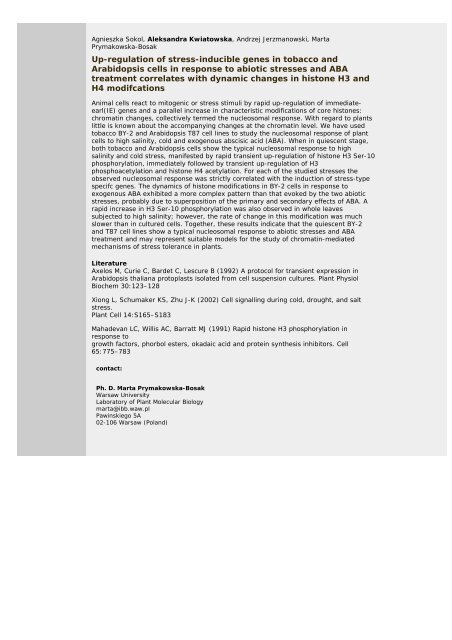Abstracts (poster) - Wissenschaft Online
Abstracts (poster) - Wissenschaft Online
Abstracts (poster) - Wissenschaft Online
Create successful ePaper yourself
Turn your PDF publications into a flip-book with our unique Google optimized e-Paper software.
Agnieszka Sokol, Aleksandra Kwiatowska, Andrzej Jerzmanowski, Marta<br />
Prymakowska-Bosak<br />
Up-regulation of stress-inducible genes in tobacco and<br />
Arabidopsis cells in response to abiotic stresses and ABA<br />
treatment correlates with dynamic changes in histone H3 and<br />
H4 modifcations<br />
Animal cells react to mitogenic or stress stimuli by rapid up-regulation of immediateearl(IE)<br />
genes and a parallel increase in characteristic modifications of core histones:<br />
chromatin changes, collectively termed the nucleosomal response. With regard to plants<br />
little is known about the accompanying changes at the chromatin level. We have used<br />
tobacco BY-2 and Arabidopsis T87 cell lines to study the nucleosomal response of plant<br />
cells to high salinity, cold and exogenous abscisic acid (ABA). When in quiescent stage,<br />
both tobacco and Arabidopsis cells show the typical nucleosomal response to high<br />
salinity and cold stress, manifested by rapid transient up-regulation of histone H3 Ser-10<br />
phosphorylation, immediately followed by transient up-regulation of H3<br />
phosphoacetylation and histone H4 acetylation. For each of the studied stresses the<br />
observed nucleosomal response was strictly correlated with the induction of stress-type<br />
specifc genes. The dynamics of histone modifications in BY-2 cells in response to<br />
exogenous ABA exhibited a more complex pattern than that evoked by the two abiotic<br />
stresses, probably due to superposition of the primary and secondary effects of ABA. A<br />
rapid increase in H3 Ser-10 phosphorylation was also observed in whole leaves<br />
subjected to high salinity; however, the rate of change in this modification was much<br />
slower than in cultured cells. Together, these results indicate that the quiescent BY-2<br />
and T87 cell lines show a typical nucleosomal response to abiotic stresses and ABA<br />
treatment and may represent suitable models for the study of chromatin-mediated<br />
mechanisms of stress tolerance in plants.<br />
Literature<br />
Axelos M, Curie C, Bardet C, Lescure B (1992) A protocol for transient expression in<br />
Arabidopsis thaliana protoplasts isolated from cell suspension cultures. Plant Physiol<br />
Biochem 30:123–128<br />
Xiong L, Schumaker KS, Zhu J-K (2002) Cell signalling during cold, drought, and salt<br />
stress.<br />
Plant Cell 14:S165–S183<br />
Mahadevan LC, Willis AC, Barratt MJ (1991) Rapid histone H3 phosphorylation in<br />
response to<br />
growth factors, phorbol esters, okadaic acid and protein synthesis inhibitors. Cell<br />
65:775–783<br />
contact:<br />
Ph. D. Marta Prymakowska-Bosak<br />
Warsaw University<br />
Laboratory of Plant Molecular Biology<br />
marta@ibb.waw.pl<br />
Pawinskiego 5A<br />
02-106 Warsaw (Poland)

















